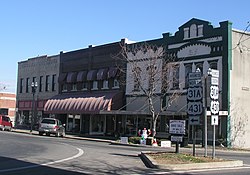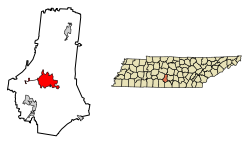Lewisburg, Tennessee | |
|---|---|
 The town square in Lewisburg | |
| Motto: "The CENTER of Southern Middle Tennessee" | |
 Location of Lewisburg in Marshall County, Tennessee | |
| Coordinates: 35°26′57″N86°47′35″W / 35.44917°N 86.79306°W | |
| Country | United States |
| State | Tennessee |
| County | Marshall |
| Incorporated | 1837 [1] |
| Named after | Meriwhether Lewis [2] |
| Government | |
| • Mayor | Jim Bingham |
| Area | |
• Total | 14.05 sq mi (36.39 km2) |
| • Land | 14.04 sq mi (36.37 km2) |
| • Water | 0.01 sq mi (0.01 km2) |
| Elevation | 738 ft (225 m) |
| Population | |
• Total | 12,288 |
| • Density | 874.96/sq mi (337.83/km2) |
| Time zone | UTC-6 (Central (CST)) |
| • Summer (DST) | UTC-5 (CDT) |
| ZIP code | 37091 |
| Area code | 931 |
| FIPS code | 47-41860 [5] |
| GNIS feature ID | 1291094 [6] |
| Website | www |
Lewisburg is a city in and the county seat of Marshall County, Tennessee, United States. [7] The population was 12,288 in 2020. Lewisburg is located in Middle Tennessee, fifty miles south of Nashville and fifty-two miles north of Huntsville, Alabama. Residents have access to the larger cities via nearby I-65.
Contents
- Geography
- Climate
- Demographics
- 2020 census
- 2000 census
- History
- Formation of Lewisburg and Early History (1807–1836)
- Education
- Notable people
- Media
- Radio stations
- References
- External links
Lewisburg was named for the explorer Meriwether Lewis. By 1838, the town was supporting a newspaper and a bank. The downtown area is similar to many other small southern towns, with a courthouse on a square, surrounded by retail and commercial businesses. Shopping centers are located on the east and west ends of town.




